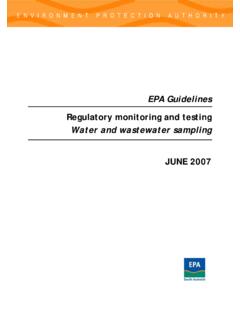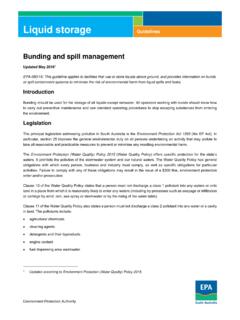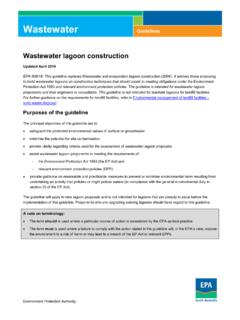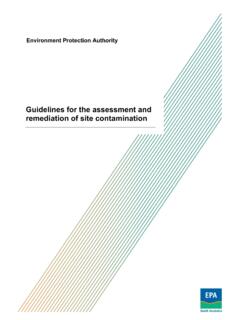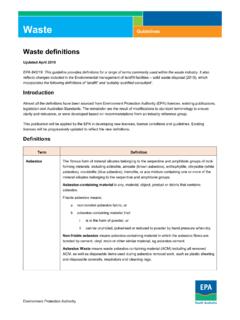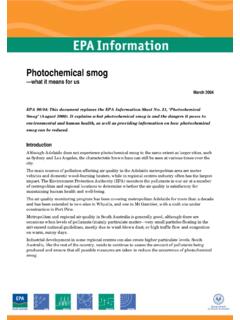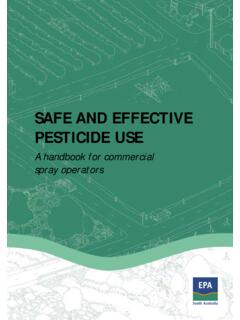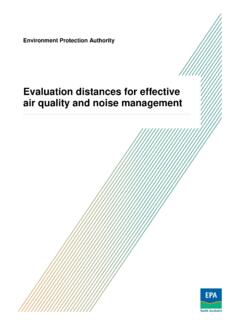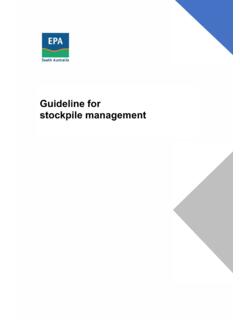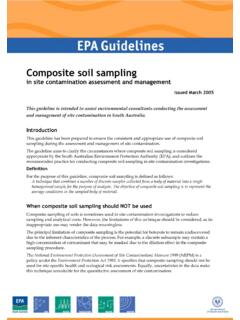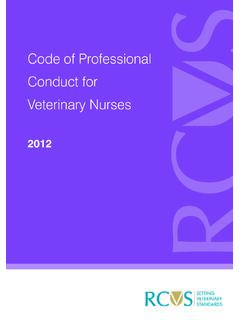Transcription of EPA Guidelines - Medical waste — storage, transport and ...
1 Medical waste storage, transport and disposal Re issued September 2003 EPA 044/03: This guideline replaces EPA Technical Bulletin No. 2, Storage, transport and disposal of Medical waste (July 1999). Introduction The management of wastes arising from health care establishments is a matter of continuing concern to workers in the waste industry and the general public. These concerns are based upon the potential for spread of infection, the risk of injury, chemical toxicity and aesthetics. It is important that the Medical profession, nurses, portering staff, laboratory staff and others dealing with Medical wastes adopt procedures that minimise risk to the environment, public, fellow workers and people working in the waste industry. What is Medical waste ? Medical waste is defined as waste consisting of: a) a needle, syringe with needle, surgical instrument or other article that is discarded in the course of Medical , dental or veterinary practice or research and has a sharp edge or point capable of inflicting a penetrating injury on a person who comes into contact with it; or b) human tissue, bone, organ, body part or foetus; or c) a vessel, bag or tube containing a liquid body substance; or d) an animal carcass discarded in the course of veterinary research or Medical practice or research; or e) a specimen or culture discarded in the course of Medical , dental or veterinary practice or research and any material that has come into contact with such a specimen or culture.
2 Or f) any other article or matter that is discarded in the course of Medical , dental or veterinary practice or research and that poses a significant risk to the health of a person who comes into contact with it. Schedule 1 Part B Environment Protection Act 1993 Medical waste : storage, transport and disposal September 2003 The following materials are not usually regarded as Medical waste unless they fall into category (f) of the Medical waste definition: dressings and bandages materials stained with or having had contact with body substances containers no longer containing body substances disposable nappies and incontinence pads sanitary napkins. Environment protection legislation Medical waste is a listed waste under Schedule 1, Part B of the Environment Protection Act 1993 (the Act).
3 Under Schedule 1, Part A of the Act any person who carries on an activity in which anything listed in Part B of the Schedule is produced as or becomes waste must be licensed. However, a licence is not required under Schedule 1, Part A of the Act if the waste is produced in the course of any of the following activities: Medical practice, not being the practice of pathology dental practice operation of a nursing home veterinary practice operation of a hospital with a capacity of less than 40 beds; or operation of an immunisation clinic. Schedule 1 Part A Activities 3 (4) This does not mean that there is no control over the disposal methods of Medical waste generated in the course of these activities. They are subject to control by the Environment Protection ( waste Management) Policy 1994 and the general environmental duty under the Act.
4 The intent of the policy is to ensure that persons who generate Medical waste from any of the above prescribed activities manage it in a fashion that does not cause or is likely to cause: environmental harm a risk to health and safety. Medical waste must not be placed into the local government domestic collection service. Requirements for storage of Medical waste Contain Medical waste in a manner that is not offensive and that minimises the threat to health, safety or the environment. Store all containers of Medical waste in a secure location. Ensure all necessary equipment required to clean and disinfect the area in case of accidental spillage is easily available and accessible. Treat any waste mixed with Medical waste , as Medical waste . Sharps such as needles, syringes with needles and surgical instruments are to be handled as follows: page 2 Medical waste : storage, transport and disposal September 2003 The disposal of sharps should not incorporate cutting, bending or any other manipulation that could generate aerosols or splatter contaminated fluids.
5 Place sharps into a suitable container that: - is puncture-resistant, leak-proof, shatter-proof and able to withstand heavy handling - displays the universal biohazard label and has a label clearly indicating the nature of the contents - has an opening which is accessible, safe to use, and designed so that it is obvious when the container is full - is sealed when full or ready for disposal - can be handled without danger of the contents spilling or falling out. Place all Medical waste other than sharps in clearly labelled heavy duty yellow plastic bags or wet strength paper bags. Bags intended for domestic use are unsuitable for this waste . Tie the bags so as to prevent leakage or expulsion of solid or liquid wastes during storage, handling or transport and ensure they will not be subject to compaction by any compacting device.
6 Collection and transport of Medical waste From a licensee Medical waste shall be collected by a transporter licensed by the Environment Protection Authority (EPA) to collect and transport such waste . A licensee wishing to transport its own waste is required to be licensed to transport Medical waste . From a prescribed activity listed on page 2 Medical waste shall be collected for disposal by: a person licensed by the EPA for the collection and transport of Medical waste a council. Or transported by a person employed or engaged in the business producing the waste directly to: a waste depot licensed by the EPA to receive Medical waste a hospital. A number of contractors provide services dedicated to the collection and transport of Medical waste . Advantages of the use of their services include: an assurance that all Medical waste is destroyed by incineration the use of personnel who are familiar with handling Medical waste and who are equipped with appropriate safety clothing, etc.
7 A reduced risk to health and safety because the transporter is knowingly handling Medical waste the use of containers which can be returned clean and disinfected the use of containers which remain intact until final disposal. page 3 Medical waste : storage, transport and disposal September 2003 Use of waste transport certificates From a licensee Each load of Medical waste collected from a person licensed as a producer of Medical waste shall be accompanied by a properly completed waste transport Certificate. This applies no matter the quantity of Medical waste collected. From a prescribed activity listed on page 2 One waste transport Certificate may be used for the collection of Medical waste from several premises. The certificate should be carried at all times and the amount of waste entered at the completion of the day s run.
8 Enter the words Medical Various in the place marked Name of waste Producer . Disposal of Medical waste Medical waste must be destroyed in an incinerator licensed by the regulatory authority in the state or territory in which the incinerator is located. Where an incinerator is not available, such as in remote areas, Medical waste may be disposed of at solid waste landfill depots licensed to receive the waste under the following conditions: Medical waste must be placed at the foot of the operating face or into a hole excavated at the depot in such a manner as to prevent contact with the public. Medical wastes must be covered with other wastes or clean fill while the waste transporter is present. The Medical waste transporter should give sufficient notice to the depot operator to allow these arrangements to be carried out.
9 Currency of these Guidelines These Guidelines offer advice to assist with compliance with the general environmental duty and specific environmental policies. They are subject to amendment and persons relying on the information should check with the EPA to ensure that it is current at any given time. FURTHER INFORMATION Legislation Legislation may be viewed on the Internet at: Copies of legislation are available for purchase from: Government Information Centre Telephone: (08) 8204 1900 77 Grenfell Street Facsimile: (08) 8204 1909 Adelaide SA 5000 Freecall (country): 1800 182 234 For general information please contact: Environment Protection Authority Telephone: (08) 8204 2004 GPO Box 2607 Facsimile: (08) 8204 9393 Adelaide SA 5001 Freecall (country): 1800 623 445 Internet: page 4
